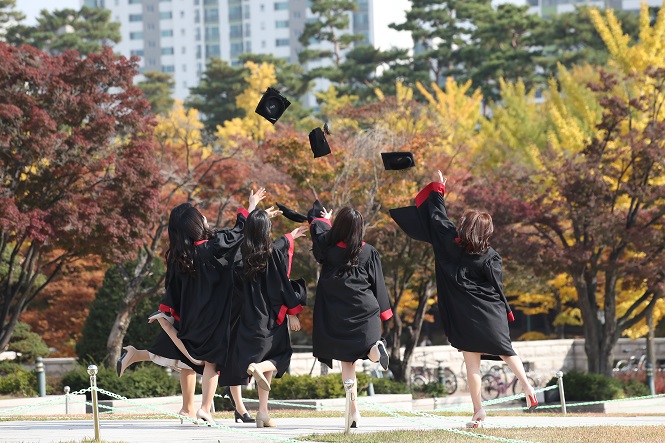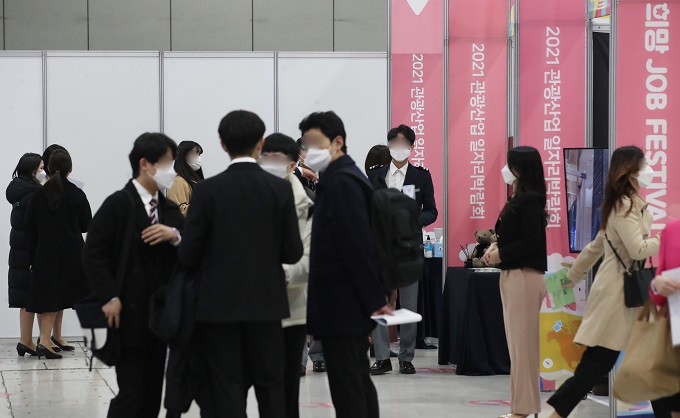
This Nov. 2, 2021, file photo shows students celebrating their university graduation at their school campus in Seoul. (Yonhap)
SEOUL, Dec. 27 (Korea Bizwire) — The employment rate of students with bachelor’s, master’s or doctorate degrees fell to a record low last year as the COVID-19 pandemic dealt a severe blow to job markets, government statistics showed Monday.
Their employment rate stood at 65.1 percent last year, the lowest since the education ministry started compiling such data in 2011, according to its statistics.
According to the statistics, 553,521 people graduated from colleges and graduate schools across the country between August 2019 and February 2020.
Of them, 480,149 were subject to employment and 312,430, or 65.1 percent, were employed, down 2 percentage points from 67.1 percent tallied in 2019.
By employment type, 284,359 were employed at workplaces providing national health care benefits, 18,139 were freelancers, 5,317 opened their own businesses and 1,131 found jobs overseas.
The proportion of company workers subscribing to workplace health insurance and freelancers increased by 0.6 percentage point and 0.1 percentage point, respectively.
But the proportion of those employed overseas and self-employed fell by 0.5 percentage point and 0.2 percentage point, respectively.
“Due to economic uncertainties stemming from the global COVID-19 pandemic, it was difficult for youths to find jobs overseas or start businesses,” the ministry said.

This Nov. 16, 2021, file photo shows people looking around different booths at a job fair in Seoul. (Yonhap)
According to the statistics, the employment rate was higher among those who finished graduate schools at 80.2 percent than those with undergraduate degrees at 61 percent.
The employment rate fell in all academic areas, with the liberal arts, natural sciences, social studies, arts and sports, and engineering sciences hit harder with a drop of over 2 percentage points.
The statistics also showed the average monthly income of college and grad school graduates working at firms providing health care benefits was around 2.63 million won (US$2,217) last year, up 33,000 won from 2.6 million won tallied the previous year.
The average monthly income of college and grad school graduates also rose to 2.44 million won and 4.49 million won, respectively.
Of the employed, 35.2 percent were recruited before graduation, while 22.7 percent found jobs within three months after graduation, 16.4 percent within nine months, 14.9 percent within six months and 10.8 percent within 10 months or more.
The biggest share of the employed, or 48.3 percent, worked at small and midsized companies, and 17.4 percent at nonprofit organizations.
Another 10.1 percent were employed at the central and local governments, 8.5 percent at conglomerates, 7.4 percent at middle market enterprises and 4.9 percent at public institutions or firms.
(Yonhap)






